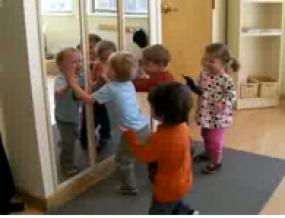How Spaces Support Social Play

We know that round spaces afford conversation, enclosed spaces afford intimacy, and high spaces afford achievement – for children as well as adults. However some features of a classroom might not be commonly identified for what they afford. In this video clip, four children race back and forth between a wall mirror and a cushioned corner. A study of this clip reveals yet another affordance of space. Let’s call it “bounding events.” You will notice that when the children race to the mirror, they press their faces close to the glass, and when they race back to the cushion corner; they tumble into its softness. These two end points contain more than location. Each offers an interesting event that emphasizes the arrival at that location. The spaces provide the children with bounding events.
Watch this clip and ask yourself: How would the rules of the game be different if the space did not have these bounding events, the interesting actions at the end points of each run? Consider the more sophisticated idea of “tagging home base” as is done in hide and seek. In hide and seek, the child has to tag home base so that he becomes ineligible for becoming the new “it.” These children, much too young for the more complicated game of hide and seek, require a more concrete reason to arrive at a particular place. They run to the mirror to see their reflection; they run to the cushion to tumble or snuggle together. The bounding events motivate the run, and later, as we discuss below, provide definite markers that one has completed this run.
A longer text analysis of the two-minute clip will be included in the zipped folder that you download. You can also find this same video and text in our Videatives Video Streaming Serviceto which you can subscribe.
Run time: 2 minutes 13 seconds for stand alone master clip.
